The China-Australia Migration Corridor: History and Heritage
Drawing on transnational approaches, this multi-disciplinary collection of essays explores the history of movement of ‘people, ideas, objects, and money’ between China and Australia that were ‘stimulated by initial acts of migration’. Its focus is the 1840s to 1940s. The book raises important issues about migrant heritage for those in the heritage industry, highlighting the importance of a historical understanding of these places that extends beyond their physical location and the nation-state.
READ REVIEW
↓
The China-Australia Migration Corridor: History and Heritage
Denis Byrne, Ien Ang and Phillip Mar | 2023
This book is the outcome of an Australian Research Council funded project and is based on interviews with 21 people, ‘several’ visits to Zhongshan (中山) in southern China over three years and informal interviews with people in villages there. The contributors approach the topic through cultural studies, Chinese diaspora studies, archaeology, heritage studies, tourism, anthropology, history and family history. While there are advantages to bringing diverse perspectives to a single topic, I found myself disappointed by the lack of deep engagement with scholarship on Australia’s Chinese history undertaken over the last half century. Of particular note was the absence of any recognition of Janis Wilton’s research on Chinese in New South Wales, that draws on place, material culture and oral history.
The book is divided into two halves. ‘Connections, Flows, Identities’ provides context for the second half of the book and includes an introduction to the history and geography of Zhongshan; the nature of surviving material culture in Australia and Zhongshan; the evolution of diasporic identities over time, drawing on Zhongshan immigrants and their descendants as examples; and an introduction to the significance of diasporic tourism. Part two, ‘Sites in the Heritage Corridor’, includes chapters that offer focused explorations of the nature of the migration corridor through the experiences of family historians returning to their home village; a typology of remittance houses in Zhongshan; the social and material legacy of Chinese Australian contributions to funding schools in Zhongshan, particularly in the 1920s and 30s and after 1978; and the built heritage legacy of immigrants from Zhongshan in Sydney’s Chinatown. The book finishes with a chapter that argues for the significance of these kinds of transnational approaches to the interpretation of built heritage.
The maps, illustrations, index and Chinese glossary are welcome additions to the overall content, although the Cantonese romanisation in the glossary does not follow a consistent romanisation system. This will not assist those already confused about the nature of Chinese languages and their romanisations.
The strongest aspects of the book are those that deal in detail with the history and heritage of Zhongshan. Williams’ mounts an interesting argument as to why the Long Du (隆都) and Liang Du (良都) regions were particular sources of emigration in Zhongshan. Cheng and Mar’s exploration of how Chinese Australian capital was used to establish educational facilities in Zhongshan provides a valuable insight into how remittances from Chinese Australians were invested in home counties. Byrne’s discussion of overseas Chinese architectural heritage got me reflecting on the tensions that exist when heritage significance is transnational in character but heritage protections are controlled by authorities in only one of those nations. And while the book did not make this point, it highlighted to me the importance of history and the work of historians in drawing out the significance of places beyond their material fabric.
The book adopts the ‘metaphor’ of a ‘migration corridor’ that links ‘nodes of settlements’ in Australia, particularly Sydney, with villages in Zhongshan as a method of understanding Chinese Australian migration. However, as a historian I found this framing constrained a deeper, more sophisticated understanding of Chinese Australian migration. In the last few decades historians have worked hard to carefully uncover Chinese Australian agency within broader forces, such as sojourning migration patterns, traditional Chinese and Confucian value systems and the impacts of racial and class hierarchies. The heavy-handed use of the migration corridor metaphor masks this agency. It also sidelines Chinese Australian mobility within Australasia and the significant role places like Hong Kong, Canton, Shanghai and even rural cities (rather than home villages) played in the lives of Chinese Australian families. It creates a hierarchy where these other places become merely ‘nodes’.
Confusingly, the ‘migration corridor’ was also defined inconsistently throughout the book. Contributors often oscillated between applying the corridor ‘metaphor’ as something linking two nations and something else more localised, such as Zhongshan–Sydney, Zhongshan-New South Wales or sometimes Zhongshan-New South Wales and Queensland. In doing so we lose the complexity of the broader picture of migration between southern China and Australia. Can we assume that migrants from other southern Chinese districts followed a similar pattern to those from Zhongshan? How complex were Chinese Australian migration pathways? What were the circumstances that drove mobility flows beyond a simple corridor between home village and new destination home? Why did migration from Zhongshan not dominate other parts of Australia? These questions and their answers are obscured by the corridor metaphor.
Despite these criticisms, this book is a welcome addition to our understanding of Chinese Australian history, highlighting how the rich and diverse connections between villages in Zhongshan, southern China and Sydney, New South Wales and how this has shaped the material culture of both places.
Hong Kong University Press published this collection under the title Heritage and history in the China-Australia migration corridor in 2023. The imprint reviewed, The China-Australia Migration Corridor: History and Heritage, was published by Melbourne University Publishing in 2023.
Reviewer: Sophie Couchman, PHA (Vic & Tas)

